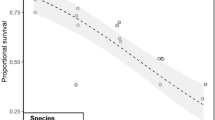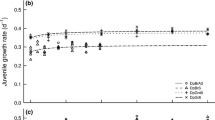Abstract
As intermediaries, some heterotrophic protists can enhance the content of the long chain n-3 essential fatty acids (LCn-3EFAs), eicosapentaenoic acid (EPA) and docosahexaenoic acid (DHA), of low food quality algae for subsequent use at higher trophic levels. However, the mechanisms that produce LCn-3EFAs are presently unknown, although LCn-3EFA production by heterotrophic protists at the phytoplankton–zooplankton interface may potentially affect the nutritional status of the pelagic system. We investigated whether the heterotrophic protists, Oxyrrhis marina and Gyrodinium dominans, produce LCn-3EFAs via elongation and desaturation of dietary LCn-3EFA precursors and/or synthesize LCn-3EFAs de novo by: (1) feeding the two heterotrophic protists with a prey deficient in n-3 fatty acids, (2) incubating them in medium containing 13C-labeled sodium acetate, and (3) feeding the two protists gelatin acacia microspheres (GAMs) containing a deuterium-labeled LCn-3EFA precursor, linolenic acid [18:3(n-3)-d4]. Both O. marina and G. dominans synthesized EPA and DHA when fed the n-3 fatty acid-deficient prey, Perkinsus marinus, a parasitic protozoan. O. marina, but not G. dominans utilized 13C-labeled acetate from the medium to produce uniformly labeled fatty acids, including DHA. Both heterotroph species consumed GAMs containing 18:3(n-3)-d4 and catabolized 18:3(n-3)-d4 to 16:3(n-3)-d4 and 14:3(n-3)-d4, while no 20 or 22 carbon metabolites of 18:3(n-3)-d4 were detected. These results suggest that O. marina and G. dominans do not elongate and desaturate dietary LCn-3EFA precursors to produce LCn-3EFAs, but rather they produce LCn-3EFAs de novo, possibly via a polyketide synthesis pathway.



Similar content being viewed by others
References
Bec A, Desvilettes C, Vera A, Lemarchand C, Fontvielle D, Bourdier G (2003) Nutritional quality of a freshwater heterotrophic dinoflagellate: trophic upgrading of its microalgal diet for Daphnia hyaline. Aquat Microb Ecol 32:203–207. doi:10.3354/ame032203
Bec A, Martin-Creuzburg D, von Elert E (2006) Trophic upgrading of autotrophic picoplankton by heterotrophic nanoflagellate Paraphysomonas sp. Limnol Oceanogr 51:1699–1707
Bligh EG, Dyer WJ (1959) A rapid method of total lipid extraction and purification. Can J Biochem Physiol 37:911–917
Boechat IG, Adrian R (2005) Biochemical composition of algivorous freshwater ciliates: you are not what you eat. FEMS Microbiol Ecol 53:393–400. doi:10.1016/j.femsec.2005.01.005
Broglio E, Jonasdottir SH, Calbet A, Jakobsen HH, Saiz E (2003) Effect of heterotrophic versus autotrophic food on feeding and reproduction of the calanoid copepod Acartia tonsa: relationship with prey fatty acid composition. Aquat Microb Ecol 31:267–278. doi:10.3354/ame031267
Christie WW (1989) Gas chromotography and lipids: a practical guide. Oily Press, Ayr
Chu F-LE, Webb KL, Hepworth DA, Casey BB (1987) Metamorphosis of larvae of Crassostrea virginica fed microencapsulated diets. Aquaculture 64:185–197. doi:10.1016/0044-8486(87)90324-3
Chu F-LE, Lund ED, Podbesek JA (2008) Quantitative significance of n-3 essential fatty acid contribution by heterotrophic protists and its ecological implication in marine pelagic food webs. Mar Ecol Prog Ser 354:85–95. doi:10.3354/meps07215
De Swaaf ME, De Rijk TC, Van der Meer P, Eggink G, Sijtsma L (2003) Analysis of docosahexaenoic acid biosynthesis in Crypthecodinium cohnii by 13C labeling and desaturase inhibitor experiments. J Biotechnol 103:21–29. doi:10.1016/S0168-1656(03)00070-1
Dolan JR (1991) Microphagous ciliates in mesohaline Chesapeake Bay waters: estimates of growth rates and consumption by copepods. Mar Biol (Berl) 111:303–309. doi:10.1007/BF01319713
Droop MR (1970) Nutritional investigation of phagotrophic protozoa under axenic conditions. Helgolander Wiss Meersunters 20:272. doi:10.1007/BF01609905
Droop MR, Pennock JF (1971) Terpenoid quinones and steroids in the nutrition of Oxyrrhis marina. J Mar Biol Assoc UK 51:455–470
Fessenden L, Cowles TJ (1994) Copepod predation on phagotrophic ciliates in Oregon coastal waters. Mar Ecol Prog Ser 107:103–111. doi:10.3354/meps107103
Kates M (1972) Techniques of lipidology; isolation analysis and identification of lipids. American Elsevier, NY
Klein-Breteler WCM, Schogt N, Baas M, Schouten S, Kraay GW (1999) Trophic upgrading of food quality by protozoans enhancing copepod growth: role of essential lipids. Mar Biol (Berl) 135:191–198. doi:10.1007/s002270050616
Lund ED, Chu F-LE, Soudant P, Harvey E (2007) Perkinsus marinus, a protozoan parasite of the eastern oyster, has a requirement for dietary sterols. Comp Biochem Physiol A 146:141–147. doi:10.1016/j.cbpa.2006.10.004
Martin-Creuzburg D, Bec A, von Elert E (2005) Trophic upgrading of picocyanobacterial carbon by ciliates for nutrition of Daphnia magna. Aquat Microb Ecol 41:271–280. doi:10.3354/ame041271
Marty Y, Delaunay F, Moal J, Samain J-F (1992) Changes in the fatty acid composition of Pecten maximus (L.) during larval development. J Exp Mar Biol Ecol 163:221–234. doi:10.1016/0022-0981(92)90051-B
Metcalfe LD, Schmitz AA (1961) The rapid preparation of fatty acid esters for gas chromatographic analysis. Anal Chem Wash 33:363. doi:10.1021/ac60171a016
Metz JG, Roessler P, Facciotti D, Levering C, Dittrich F, Lassner M et al (2001) Production of polyunsaturated fatty acids by polyketide synthases in both prokaryotes and eukaryotes. Science 293:290–293. doi:10.1126/science.1059593
Napier JA (2002) Plumbing the depths of PUFA biosynthesis: a novel polyketide synthase-like pathway from marine organisms. Trends Plant Sci 7:51–54. doi:10.1016/S1360-1385(01)02191-4
Pereira SL, Leonard AE, Mukerji P (2003) Recent advances in the study of fatty acid desaturases from animals and lower eukaryotes. Prostaglandins Leukot Essent Fatty Acids 68:97–106. doi:10.1016/S0952-3278(02)00259-4
Qui X (2003) Biosynthesis of docosahexaenoic acid (DHA, 22:6–4, 7, 10, 13, 16, 19): two distinct pathways. Prostaglandins Leukot Essent Fatty Acids 68:181–186. doi:10.1016/S0952-3278(02)00268-5
Ratledge C (2004) Fatty acid biosynthesis in microogranisms being used for single cell oil production. Biochimie 86:807–815. doi:10.1016/j.biochi.2004.09.017
Rein KS, Barrone J (1999) Polyketides from dinoflagellates: origins, pharmacology, and biosynthesis. Comp Biochem Physiol B 124:117–131. doi:10.1016/S0305-0491(99)00107-8
Soudant P, Chu FLE (2001) Lipid class and fatty acid composition of the protozoan parasite of oysters, Perkinsus marinus cultivated in two different media. J Eukaryot Microbiol 48:309–319. doi:10.1111/j.1550-7408.2001.tb00319.x
Tang K, Taal M (2005) Trophic modification of food quality by heterotrophic protists: species-specific effects on copepod egg production and egg hatching. J Exp Mar Biol Ecol 318:85–98. doi:10.1016/j.jembe.2004.12.004
Tang K, Jakobsen HH, Visser AW (2001) Phaeocystis globosa (Prymnesiophyceae) and the planktonic food web: feeding, growth, and trophic interactions among grazers. Limnol Oceanogr 46:1860–1870
Uttaro AD (2006) Biosynthesis of polyunsaturated fatty acids in lower eukaryotes. IUBMB Life 58:563–571. doi:10.1080/15216540600920899
Veloza AJ, Chu FLE, Tang KW (2006) Trophic modification of essential fatty acids by heterotrophic protists and its effects on the fatty acid composition of the copepod Acartia tonsa. Mar Biol (Berl) 148:779–788. doi:10.1007/s00227-005-0123-1
Wallis JG, Watts JL, Browse J (2002) Polyunsaturated fatty acid synthesis: what will they think of next? Trends Biochem Sci 27:467–473. doi:10.1016/S0968-0004(02)02168-0
Zeldis J, James MR, Grieve J, Richards L (2002) Omnivory by copepods in the New Zealand subtropical frontal zone. J Plankton Res 24:9–23. doi:10.1093/plankt/24.1.9
Zhukova NV, Kharlamenko VI (1999) Sources of essential fatty acids in marine microbial loop. Aquat Microb Ecol 17:153–157. doi:10.3354/ame017153
Acknowledgments
This study was supported by OCE, NSF (award #:0525899). The authors are grateful for Jennifer A. Podbesek’s help in culturing the protist and algal cultures. Contribution no. 2939 by the Virginia Institute of Marine Science, College of William and Mary.
Author information
Authors and Affiliations
Corresponding author
Additional information
Communicated by U.-G. Berninger.
Rights and permissions
About this article
Cite this article
Lund, E.D., Chu, FL.E., Harvey, E. et al. Mechanism(s) of long chain n-3 essential fatty acid production in two species of heterotrophic protists: Oxyrrhis marina and Gyrodinium dominans . Mar Biol 155, 23–36 (2008). https://doi.org/10.1007/s00227-008-1003-2
Received:
Accepted:
Published:
Issue Date:
DOI: https://doi.org/10.1007/s00227-008-1003-2




